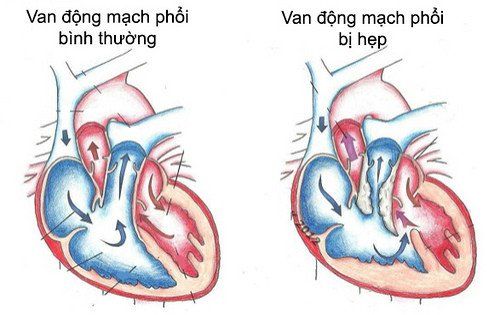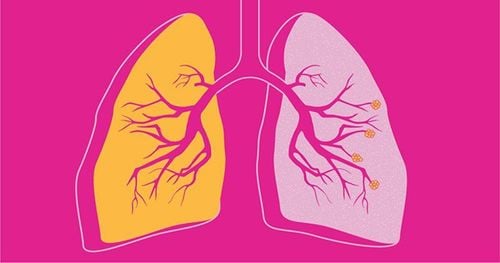This is an automatically translated article.
Pulmonary branch stenosis is a congenital heart disease, when severe stenosis will cause right heart failure, the main treatment method is pulmonary artery stenosis, the success rate is high, with positive results.
1. What is pulmonary branch stenosis?
Pulmonary artery stenosis is a congenital heart disease, it can be seen in other congenital heart diseases such as: Pulmonary branch stenosis combined with stenosis of the valve and pulmonary valve in congenital Rubella syndrome, arteriovenous stenosis Pulmonary vessels after surgery for Fallot disease 4...
Instead of opening and closing to allow blood to travel from the heart to the lungs, the valve is formed as a solid tissue. So the blood cannot move normally to get oxygen from the lungs. Instead, some of the blood travels to the lungs via other natural pathways in the heart and its arteries. When severe pulmonary stenosis will cause right heart failure, the main treatment method is pulmonary branch dilatation, high success rate, with positive results.
2. Indications for pulmonary artery stenosis

Hẹp động mạch phổi là bệnh rất thường gặp
Pulmonary branch angioplasty is indicated in the following cases:
Newborns with symptomatic pulmonary valve stenosis, transpulmonary valve gradient <40 mmHg in the setting of low or normal cardiac output, and ductal arteriosus right-left shunt circuit. Children with moderate to severe pulmonary stenosis with symptoms should have pulmonary artery stenosis. It is best done when the baby is 9-12 months old. In adults, angioplasty is indicated in the setting of pulmonary stenosis with a transvalvular gradient >64 mmHg. Adults with clinical symptoms due to pulmonary valve stenosis; right ventricular failure; two-chamber right ventricle; arrhythmias associated with pulmonary valve stenosis; right-left shunt in the heart. Adults with pulmonary valve stenosis accompanied by other complicated lesions requiring surgical treatment such as: stenosis with outlet stenosis; narrow round of text; with ventricular septal defect; The patient is in a state of severe infection; severe coagulopathy... Pulmonary valve has been heavily calcified, fibrosis in adults.
3. Pulmonary artery stenosis procedure

Gây mê trước khi nong hẹp nhánh động mạch phổi
Step 1: Ask the patient to lie on their back, arms raised overhead. Then, anesthetize according to the anaesthetic procedure. Step 2: A puncture of the femoral vein, if necessary, add a femoral artery. Insert the catheter and lead into the right atrium through the femoral vein, then through the tricuspid valve into the right ventricle, up the pulmonary artery. Step 3: Measure right ventricular pressure, pulmonary artery. Step 4: Capture the right ventricle, pulmonary artery trunk, and pulmonary artery branch with contrast with the left 90 degree tilt position, 20 degree head oblique position with 30 degree left or right tilt. Step 5: Measure the trunk diameter, branch and narrow position of the pulmonary artery branch on the angiogram. Select a balloon balloon with the ratio of balloon diameter to the narrow diameter of the pulmonary artery branch is 1.2 - 1.4 times Step 6: Bring the balloon to the position of the narrow pulmonary artery branch, then inflate the balloon and then deflate the balloon. ball very quickly in about < 15 seconds, can be repeated several times. Step 7: Re-measure right ventricular pressure, pulmonary artery stem and distal segment after the stenosis of the pulmonary artery branch and evaluate the results Step 8: After pulmonary angioplasty, remove the entire catheter and lead , the device opens the blood vessel out of the femoral vein, squeezes the femoral vein by hand, when the bleeding stops, compresses it with an elastic bandage.
4. Handling accidents

Chảy máu màng ngoài tim cần truyền máu
Pericardial bleeding: In this case need blood transfusion, pericardial aspiration, surgery when necessary. Venous bleeding due to tear: compression bandages, blood transfusion, surgery when necessary for the patient. Cardiac arrhythmia: Use of arrhythmia drugs, electric shock... Hematoma at femoral vein puncture: Need to bandage, stitch to stop bleeding... Vinmec International General Hospital with its facilities and equipment With modern medical equipment and a team of experts and doctors with many years of experience in medical examination and treatment, patients can rest assured that they will be examined and treated at the Hospital.
To register for examination and treatment at Vinmec International General Hospital, you can contact Vinmec Health System nationwide, or register online HERE.
SEE MORE
Overview of common lung diseases What is pulmonary hypertension? Pulmonary stenosis: Causes, symptoms, diagnosis and treatment













